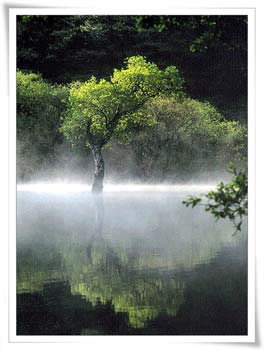3.2: Taking photos of landscapes
- Page ID
- 151085
In this chapter, you will learn techniques for taking photos of landscapes
- Parallel a photo frame with horizon
- Use innovative composition based on basic composition
Parallel the frames with the horizon:
If you are photographing landscapes which include the horizon, it is a good idea to make the frame parallel to the horizon, by placing it at the one-third line as in the picture shown on the right.

Paralleled horizon
You can apply various basic compositions to your photos as follows. Furthermore you can make your own innovative compositions in your photo.

The rule of thirds

Symmetrical composition
- Increase the value of the aperture setting
- Change the EV value
- Make the shutter speed slower
- Use a tripod
Increase the value of the aperture setting:
• As in the opposite photo, increasing the aperture setting makes a wide depth of field that focuses in front of and behind the subjects. This technique is generally available in daylight. Night photographs use a different aperture setting. You will learn this in a later lesson.

All subjects were focused
Change EV value:
• If you are taking a picture in sunset or sunrise, you should consider the exposure of your camera. Usually using -1EV or -2EV is useful in taking
photos like the one shown on the right.

Taken by -2 EV
Make the shutter speed slower:
The water is blurred and appears to be moving in the photo on the right. If you use a slower shutter speed, the area surrounding the creek or waterfall remains in focus, but the water becomes blurred and takes on a mood. You have learned how to use the shutter speed priority mode. If you want to make an effect similar to the sample photo, change the camera setting so that the shutter speed is no faster than 1/4 of a second. Depending on the speed of the water, you can adjust the shutter speed. Remember that most point-and-shoot cameras (regular digital cameras) make the aperture opening smaller(increase F number) if the shutter is open longer (a slower shutter speed). So you should check the brightness of your photo after changing the shutter speed. You can change shutter speed even if your camera does not have the shutter speed priority mode. If your camera has the aperture priority mode, set your aperture to the smallest setting. The smaller the aperture, the longer the shutter must stay open.
① Mount the camera on a tripod or stable platform

② Compose the image you want to capture

③ Change the shutter speed to no faster than 1/4 of a second

④ Take a photo, review, adjust, and shoot again if necessary

